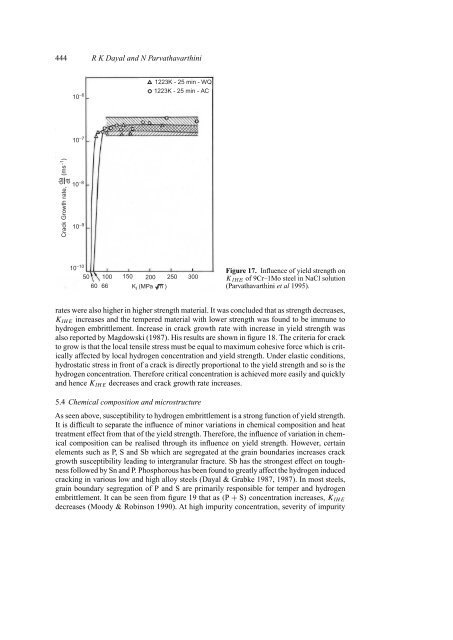Hydrogen embrittlement in power plant steels - Indian Academy of ...
Hydrogen embrittlement in power plant steels - Indian Academy of ...
Hydrogen embrittlement in power plant steels - Indian Academy of ...
You also want an ePaper? Increase the reach of your titles
YUMPU automatically turns print PDFs into web optimized ePapers that Google loves.
444 R K Dayal and N Parvathavarth<strong>in</strong>i<br />
10 −6<br />
1223K - 25 m<strong>in</strong> - WQ<br />
1223K - 25 m<strong>in</strong> - AC<br />
10 −7<br />
da<br />
Crack Growth rate, (ms −1 )<br />
dt<br />
10 −8<br />
10 −9<br />
10 −10<br />
50 100 150 200 250 300<br />
60 66 K I (MPa m )<br />
Figure 17. Influence <strong>of</strong> yield strength on<br />
K IHE <strong>of</strong> 9Cr–1Mo steel <strong>in</strong> NaCl solution<br />
(Parvathavarth<strong>in</strong>i et al 1995).<br />
rates were also higher <strong>in</strong> higher strength material. It was concluded that as strength decreases,<br />
K IHE <strong>in</strong>creases and the tempered material with lower strength was found to be immune to<br />
hydrogen <strong>embrittlement</strong>. Increase <strong>in</strong> crack growth rate with <strong>in</strong>crease <strong>in</strong> yield strength was<br />
also reported by Magdowski (1987). His results are shown <strong>in</strong> figure 18. The criteria for crack<br />
to grow is that the local tensile stress must be equal to maximum cohesive force which is critically<br />
affected by local hydrogen concentration and yield strength. Under elastic conditions,<br />
hydrostatic stress <strong>in</strong> front <strong>of</strong> a crack is directly proportional to the yield strength and so is the<br />
hydrogen concentration. Therefore critical concentration is achieved more easily and quickly<br />
and hence K IHE decreases and crack growth rate <strong>in</strong>creases.<br />
5.4 Chemical composition and microstructure<br />
As seen above, susceptibility to hydrogen <strong>embrittlement</strong> is a strong function <strong>of</strong> yield strength.<br />
It is difficult to separate the <strong>in</strong>fluence <strong>of</strong> m<strong>in</strong>or variations <strong>in</strong> chemical composition and heat<br />
treatment effect from that <strong>of</strong> the yield strength. Therefore, the <strong>in</strong>fluence <strong>of</strong> variation <strong>in</strong> chemical<br />
composition can be realised through its <strong>in</strong>fluence on yield strength. However, certa<strong>in</strong><br />
elements such as P, S and Sb which are segregated at the gra<strong>in</strong> boundaries <strong>in</strong>creases crack<br />
growth susceptibility lead<strong>in</strong>g to <strong>in</strong>tergranular fracture. Sb has the strongest effect on toughness<br />
followed by Sn and P. Phosphorous has been found to greatly affect the hydrogen <strong>in</strong>duced<br />
crack<strong>in</strong>g <strong>in</strong> various low and high alloy <strong>steels</strong> (Dayal & Grabke 1987, 1987). In most <strong>steels</strong>,<br />
gra<strong>in</strong> boundary segregation <strong>of</strong> P and S are primarily responsible for temper and hydrogen<br />
<strong>embrittlement</strong>. It can be seen from figure 19 that as (P + S) concentration <strong>in</strong>creases, K IHE<br />
decreases (Moody & Rob<strong>in</strong>son 1990). At high impurity concentration, severity <strong>of</strong> impurity
















